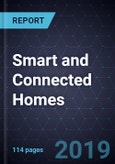Partnerships Between Smart-home Product Providers and Utility, Telecom, Insurance, and Online Retail Companies are Crucial for Mass Market Adoption
The smart and connected homes market is an evolving and dynamic sector that is poised for solid growth in the next 7 years. The market is mainly driven by demand for enhanced safety and personal comfort, increased energy and cost savings, growing acceptance of new products, improved adoption of high-speed Internet connectivity in developing countries, new business models, and enhanced competition from different market participants.
The total smart and connected homes market is estimated to reach $262.63 billion growing at a compound annual growth rate (CAGR) of 7.5% till 2025. The CAGR would be in double digits if smart TVs were not considered in the total market revenue; however, we have chosen to include it in the scope of this research study, as it is an integral part of the smart home ecosystem.
The home entertainment segment contributed 82.7% of the total market revenue and will continue to remain the highest contributor in the forecast period as well. Home energy management systems (HEMS) segment is expected to witness accelerated growth with a CAGR of 21.0% till 2025.
Research Scope
The scope of the study includes five key segments: home energy management, home automation, home safety and security, home entertainment, and health and wellness. The publisher approaches each smart home segment as a separate market and has identified unique product-level architecture for easy identification for products and has provided an analysis of the same.
Home Energy Management Systems (HEMS):
This system is a technology platform that monitors, manages, and controls home functions, such as HVAC, lighting, solar PV, and other appliances in a residential building. The scope of the study covers both hardware and software. Hardware includes ‘hub’ devices, smart plugs, smart thermostats, smart clamps, and in-home displays (IHDs), which are interconnected in a wireless mesh network called the Home Area Network (HAN).
Home Automation and Control:
A home automation system is a centralized system that controls and automates at least two home functions from remote locations, thereby providing an assisted and connected the living environment to end-users.
The study includes both simple and advanced automation products. Simple home automation products include Sensors and controllers such as occupancy sensors, light sensors, daylight dimming sensors, CO2 sensor, air quality sensor, humidity sensor, lighting and
HVAC controllers, home gateways, smart AC vents, smart kitchen appliances, and management software and mobile applications.
Advanced automation products include smart windows, automated window blinds, shutters, garage doors, roof windows, and shutter controllers.
Home Safety and Security:
Home safety and security products include smart IP cameras (such as Nest Cam and Ring device) alarm systems, smart locks, motion sensors, flood sensors, door/window sensors, and smoke sensors.
Home Entertainment:
A home entertainment system is a multi-room system that controls and automates home entertainment devices and provides high-quality audio/video experience for end-users. Home entertainment is a combination of both hardware and software products. Home entertainment products include smart TVs, smart speakers, connected audio systems, and digital media streamers.
Health and Wellness:
Health and wellness are also known as technology-enabled care (TEC) that involves mobile health, digital health, and telehealth. Health and wellness is a combination of hardware and software as shown in the chart.
Health and wellness products include wearable devices that track vitals, sleep, and physical activities; and remote health monitors. Software and services include health and fitness management applications, telehealth and mHealth, health education, health engagement, and virtual care.
The geographic scope of the study includes North America, Europe, and the Commonwealth of Independent States (CIS), Asia-Pacific, the Middle East, and Africa, and Latin America.
The publisher has estimated the penetration of smart homes in different countries across the globe and analyzed the same.








